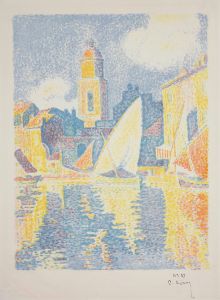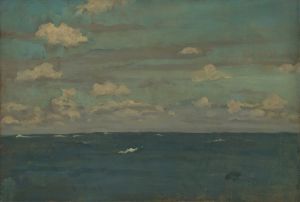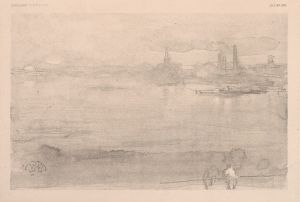
The Venetian Mast
A hand-painted replica of James Abbott McNeill Whistler’s masterpiece The Venetian Mast, meticulously crafted by professional artists to capture the true essence of the original. Each piece is created with museum-quality canvas and rare mineral pigments, carefully painted by experienced artists with delicate brushstrokes and rich, layered colors to perfectly recreate the texture of the original artwork. Unlike machine-printed reproductions, this hand-painted version brings the painting to life, infused with the artist’s emotions and skill in every stroke. Whether for personal collection or home decoration, it instantly elevates the artistic atmosphere of any space.
"The Venetian Mast" is a painting by the American artist James Abbott McNeill Whistler, created during his time in Venice. Whistler, born on July 10, 1834, in Lowell, Massachusetts, was a prominent figure in the American and European art scenes during the late 19th century. He is best known for his distinctive style and his contributions to the Aesthetic Movement, which emphasized art for art's sake.
Whistler arrived in Venice in September 1879, having been commissioned by the Fine Art Society of London to create a series of etchings and pastels. This period in Venice proved to be highly productive for Whistler, resulting in some of his most celebrated works. "The Venetian Mast" is one of these works, capturing the unique atmosphere and architectural beauty of the city.
The painting depicts a scene in Venice, characterized by its intricate details and the use of a limited color palette, which is typical of Whistler's style. The composition focuses on a tall mast, which is a common feature in Venetian architecture, often used for hoisting flags. The mast is set against the backdrop of Venetian buildings, with their distinct Gothic and Renaissance architectural elements. Whistler's use of light and shadow in the painting creates a sense of depth and realism, while also conveying the serene and timeless quality of Venice.
Whistler's technique in "The Venetian Mast" reflects his mastery of both line and color. He often employed a method known as "tonalism," where subtle gradations of color and tone are used to create a harmonious and atmospheric effect. This approach is evident in the soft, muted hues of the painting, which evoke the gentle light of Venice and the reflective quality of its canals.
During his time in Venice, Whistler was deeply influenced by the city's unique charm and its rich artistic heritage. He spent much of his time exploring the narrow streets, canals, and historic buildings, capturing their essence in his art. His Venetian works, including "The Venetian Mast," are celebrated for their ability to convey the city's ethereal beauty and its sense of history.
Whistler's Venetian period marked a significant phase in his career, as he experimented with new techniques and approaches to composition. His works from this time were well-received by critics and collectors, further establishing his reputation as a leading artist of his era. "The Venetian Mast" stands as a testament to Whistler's skill and his ability to capture the spirit of a place through his art.
In summary, "The Venetian Mast" by James Abbott McNeill Whistler is a notable example of the artist's work during his productive period in Venice. The painting showcases Whistler's distinctive style, characterized by its tonal harmony, attention to detail, and atmospheric quality. Through this work, Whistler successfully captures the timeless beauty and unique character of Venice, solidifying his legacy as a masterful painter.


















